#samuel goldwyn films
Explore tagged Tumblr posts
Text
youtube
Curse Of The Sin Eater | Official Trailer HD
Dir: Justin Denton Star: Carter Shimp / Elizabeth Laidlaw / Marcelo Wright
#curse of the sin eater#justin denton#horror movies#thriller movies#trailer#samuel goldwyn films#Youtube
9 notes
·
View notes
Text
The Outside Story (2020) Review
*Spoiler Alert* Oh my goodness, I absolutely loved this movie until the end. That sentiment perfectly sums up my experience with The Outside Story, a charming and heartfelt indie gem that takes us on a surprisingly intimate journey of self-reflection, connection, and rediscovery. Directed by Casimir Nozkowski, this film revolves around Charles (played by Brian Tyree Henry), a man stuck—both…
#Alexander Trimpe#Brian Tyree Henry#brooklyn films#Casimir Nozkowski#Character growth in movies#film#film review#independent films#indie drama films#Indie movie reviews#Movie blogs#movie reaction#movie review#new york#New York Film#quirky comedies#review#Romantic drama comedy#Samuel Goldwyn Films#The Outside Story (2020) review#The Outside Story movie review
0 notes
Text
Official Trailer - SOMETHING IN THE WATER!

View On WordPress
0 notes
Text
Watch "The Outlaw Johnny Black | Official Teaser Trailer 4K" on YouTube
youtube
0 notes
Text

Alexander Korda with United Artists founders Samuel Goldwyn, Mary Pickford and Charlie Chaplin and also Robert Fairbanks, Los Angeles, 1935
#mary pickford#alexander korda#samuel goldwyn#charlie chaplin#robert fairbanks#old hollywood#classic film#1930s
106 notes
·
View notes
Text
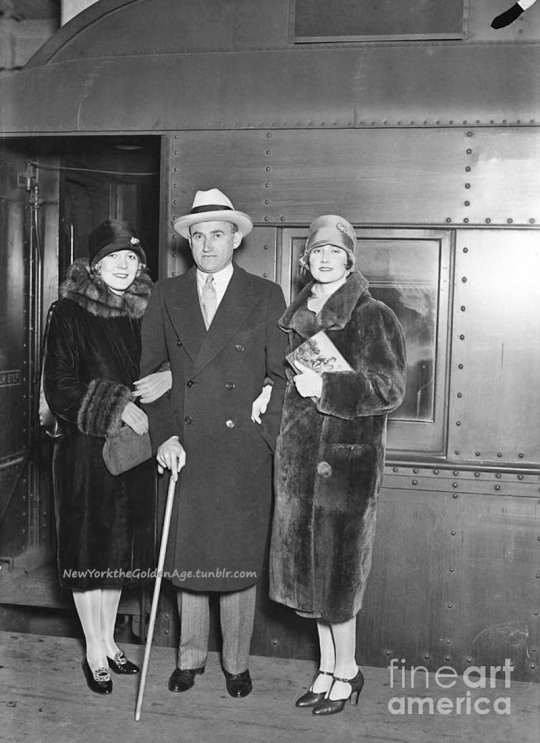
Silent film star Vilma Banky, left, greets producer Samuel Goldwyn and his wife, the former Frances Howard, on the Goldwyns' arrival from the West Coast, December 1926.
Photo: Bettmann Archive/Getty Images/Fine Art America
#vintage New York#1920s#Vilma Banky#Samuel Goldwyn#silent movies#silent film star#vintage railroad#Frances Howard#vintage NYC
94 notes
·
View notes
Text

October 1935
#merle oberon#herbert marshall#fredric march#the dark angel#dark angel#1935#1930s#samuel goldwyn#mgm#hollywood#old hollywood#classic hollywood#vintage hollywood#movie poster#movie ad#classic film#classic movies#movie magazine#modern screen#modern screen magazine
39 notes
·
View notes
Text
FARLEY GRANGER — VOLUNTEERS WANTED!
hello, old hollywood world!!! my name is trebo, and i’m a dedicated fan of the late farley granger. alongside a friend of mine, we decided we wanted to kickstart an official farley instagram page. but we need your help!
starting an official page calls for contacting any living relatives, family members or acquaintances of farley himself. we have already compiled a list of names with contacts and we are looking for fellow fans who believe they are dedicated* to helping our cause.
our goal is to maintain the life and legacy of farley granger by spreading his story. the official account would be run by fans and relatives collaboratively.
please send me a message here, or on instagram @ tatham._ if you are interested in helping. by simply reblogging this post, you are already helping us move forward towards this goal. thank you so much for sharing.
*has extensive knowledge/understanding of farley’s life, career, family, and history and can provide materials or information that others may not have access to.
tags: @antonivs @urmomisgay0 @tremendously-exhilarated @punkat-13 @rockabully @atiyaxa @ant1m0ny @sewerfight @cliffsteelesbf

#strangers on a train#farley granger#rope 1948#strangers on a train 1951#robert walker#guy haines#phillip morgan#old hollywood#movies#old hollywood movies#films#cinema#research#movie history#classic hollywood#old hollywood stars#old hollywood actors#they live by night#classic film stars#classic movies#1950s#1940s#1960s#samuel goldwyn#alfred hitchcock#leonard bernstein#arthur laurents#shelley winters#ava gardner#dana andrews
16 notes
·
View notes
Text
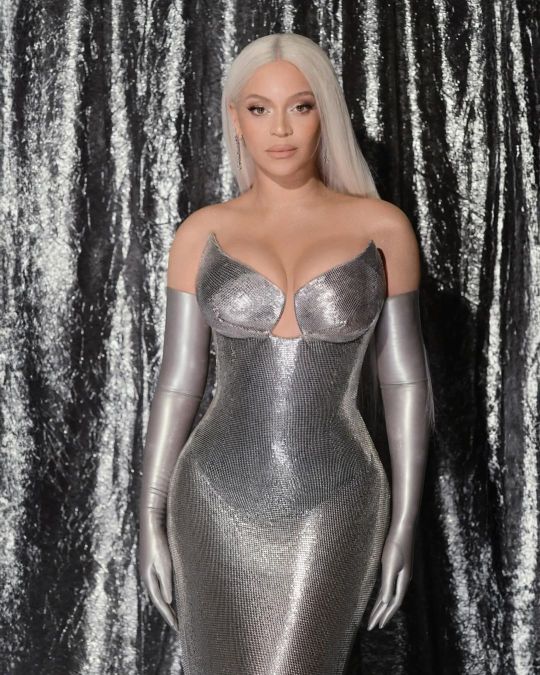

Beyoncé wearing custom Versace attends the world premiere of Renaissance: A Film By Beyoncé (2023)
#Beyoncé#Renaissance: A film by Beyoncé#renaissance#renaissance world tour#Concert Film#Samuel Goldwyn Theater
53 notes
·
View notes
Text
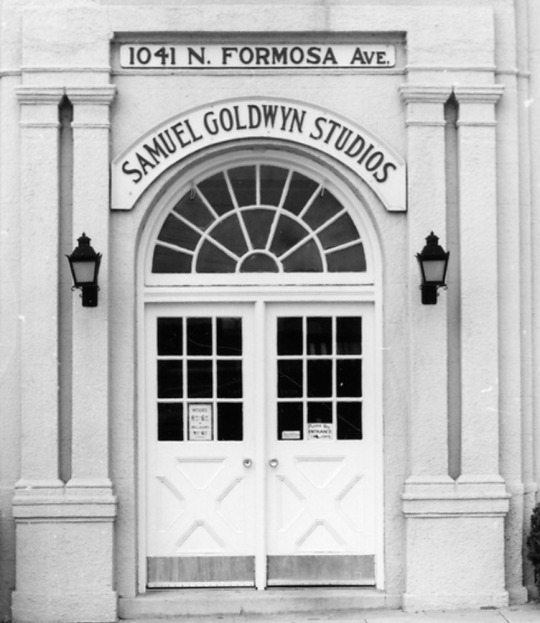
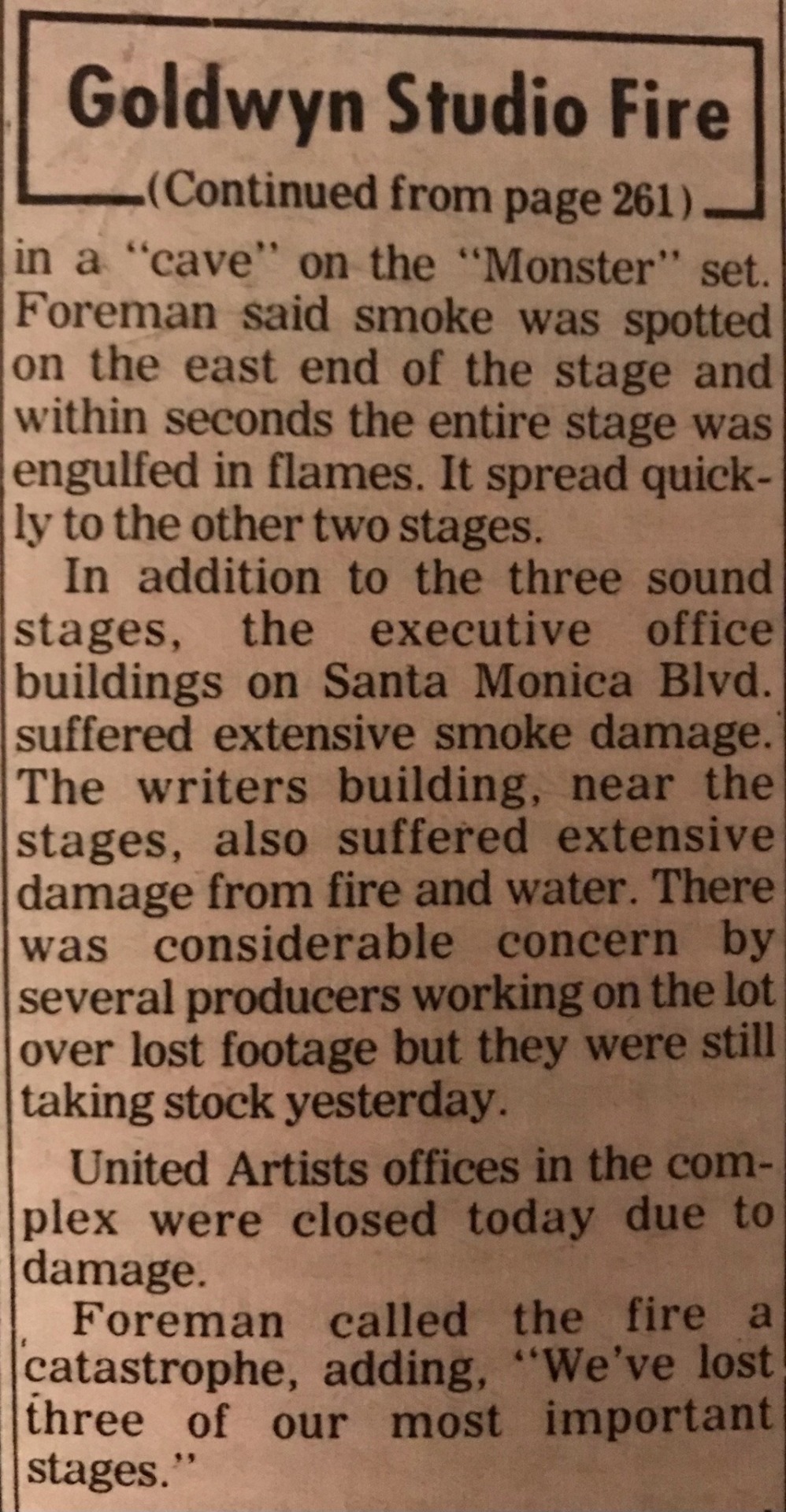
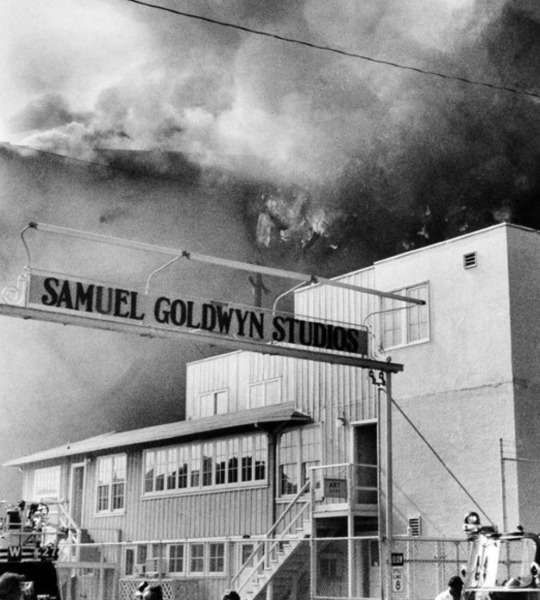
1974.
Sigmund and the Sea Monsters nearly burned down Samuel Goldwyn Studios, one of Hollywood's most historic lots.
10 notes
·
View notes
Text
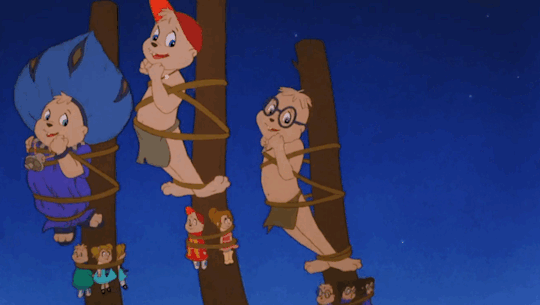
Wooly Bully “The Chipmunk Adventure” (1987)
#80s#80s film#the chipmunk adventure#alvin and the chipmunks#the chipettes#gif#dancing#samuel goldwyn#bagdasarian productions
9 notes
·
View notes
Text
in honor of that anon who said jews have done nothing for the world, here’s a non exhaustive list of things we’ve done for the world:
arts, fashion, and lifestyle:
jeans - levi strauss
modern bras - ida rosenthal
sewing machines - isaac merritt singer
modern film industry - carl laemmle (universal pictures), adolph zukor (paramount pictures), william fox (fox film forporation), louis b. mayer (mgm - metro-goldwyn-mayer), harry, sam, albert, and jack warners (warner bros.), steven spielberg, mel brooks, marx brothers
operetta - jacques offenbach
comic books - stan lee
graphic novels - will eisner
teddy bears - morris and rose michtom
influential musicians - irving berlin, stephen sondheim, benny goodman, george gershwin, paul simon, itzhak perlman, leonard bernstein, bob dylan, leonard cohen
artists - mark rothko
actors - elizabeth taylor, jerry lewis, barbara streisand
comedians - lenny bruce, joan rivers, jerry seinfeld
authors - judy blume, tony kushner, allen ginsberg, walter mosley
culture:
esperanto - ludwik lazar zamenhof
feminism - betty friedan, gloria steinem, ruth bader ginsberg
queer and trans rights - larry kramer, harvey milk, leslie feinberg, abby stein, kate bornstein, frank kameny, judith butler
international women's day - clara zetkin
principles of journalizm, statue of liberty, and pulitzer prize - joseph pulitzer
"the new colossus" - emma lazarus
universal declaration of human rights - rene samuel cassin
holocaust remembrance and human rights activism - elie wiesel
workers rights - louis brandeis, rose schneiderman
public health care, women's rights, and children's rights - lillian wald
racial equity - rabbi abraham joshua heschel, julius rosenwald, andrew goodman, michael schwerner
political theory - hannah arendt
disability rights - judith heumann
black lives matter slogan and movement - alicia garza
#metoo movement - jodi kantor
institute of sexology - magnus hirschfeld
technology:
word processing computers - evelyn berezin
facebook - mark zuckerberg
console video game system - ralph henry baer
cell phones - amos edward joel jr., martin cooper
3d - leonard lipton
telephone - philipp reis
fax machines - arthur korn
microphone - emile berliner
gramophone - emile berliner
television - boris rosing
barcodes - norman joseph woodland and bernard silver
secret communication system, which is the foundation of the technology used for wifi - hedy lamarr
three laws of robotics - isaac asimov
cybernetics - norbert wiener
helicopters - emile berliner
BASIC (programming language) - john george kemeny
google - sergey mikhaylovich brin and larry page
VCR - jerome lemelson
fax machine - jerome lemelson
telegraph - samuel finley breese morse
morse code - samuel finley breese morse
bulletproof glass - edouard benedictus
electric motor and electroplating - boris semyonovich jacobi
nuclear powered submarine - hyman george rickover
the internet - paul baran
icq instant messenger - arik vardi, yair goldfinger,, sefi vigiser, amnon amir
color photography - leopold godowsky and leopold mannes
world's first computer - herman goldstine
modern computer architecture - john von neumann
bittorrent - bram cohen
voip internet telephony - alon cohen
data archiving - phil katz, eugene roshal, abraham lempel, jacob ziv
nemeth code - abraham nemeth
holography - dennis gabor
laser - theodor maiman
instant photo sharing online - philippe kahn
first automobile - siegfried samuel marcus
electrical maglev road - boris petrovich weinberg
drip irrigation - simcha blass
ballpoint pen and automatic gearbox - laszlo biro
photo booth - anatol marco josepho
medicine:
pacemakers and defibrillators - louise robinovitch
defibrillators - bernard lown
anti-plague and anti-cholera vaccines - vladimir aronovich khavkin
polio vaccine - jonas salk
test for diagnosis of syphilis - august paul von wasserman
test for typhoid fever - ferdinand widal
penicillin - ernst boris chain
pregnancy test - barnhard zondek
antiretroviral drug to treat aids and fight rejection in organ transplants - gertrude elion
discovery of hepatitis c virus - harvey alter
chemotherapy - paul ehrlich
discovery of prions - stanley prusiner
psychoanalysis - sigmund freud
rubber condoms - julius fromm
birth control pill - gregory goodwin pincus
asorbic acid (vitamin c) - tadeusz reichstein
blood groups and rh blood factor - karl landsteiner
acyclovir (treatment for infections caused by herpes virus) - gertrude elion
vitamins - caismir funk
technique for measuring blood insulin levils - rosalyn sussman yalow
antigen for hepatitus - baruch samuel blumberg
a bone fusion technique - gavriil abramovich ilizarov
homeopathy - christian friedrich samuel hahnemann
aspirin - arthur ernst eichengrun
science:
theory of relativity - albert einstein
theory of the electromagnetic field - james maxwell
quantum mechanics - max born, gustav ludwig hertz
quantum theory of gravity - matvei bronstein
microbiology - ferdinand julius cohn
neuropsychology - alexander romanovich luria
counters for x-rays and gamma rays - robert hofstadter
genetic engineering - paul berg
discovery of the antiproton - emilio gino segre
discovery of cosmic microwave background radiation - arno allan penzias
discovery of the accelerating expansion of the universe - adam riess and saul merlmutter
discovery that black hole formation is a robust prediction of the general theory of relativity - roger penrose
discovery of a supermassive compact object at the center of the milky way - andrea ghez
modern cosmology and the big bang theory - alexander alexandrovich friedmann
stainless steel - hans goldschmidt
gas powered vehicles
interferometer - albert abraham michelson
discovery of the source of energy production in stars - hans albrecht bethe
proved poincare conjecture - grigori yakovlevich perelman
biochemistry - otto fritz meyerhof
electron-positron collider - bruno touschek
3K notes
·
View notes
Text
Ronald Colman and Vilma Bánky were possibly THE most popular romantic pairing of the silent era!!! They played all sorts of roles together but they consistently had heaps of chemistry and always looked absolutely stunning together!!!! They're so adorable in The Winning of Barbara Worth (1926) and they have some of the most insane sexual tension in The Night of Love (1927) I've ever seen!!!!!
They starred in five films together; the only reason there are not more is that they were so successful Samuel Goldwyn thought he could make even more money if he split them up so that they'd individually draw audiences.
Here they are being adorable as she's patching him up: https://youtu.be/BrSj0uHnrXg?si=6X-a-rXU6F4gmRXv
Looking gorgeous:






36 notes
·
View notes
Text
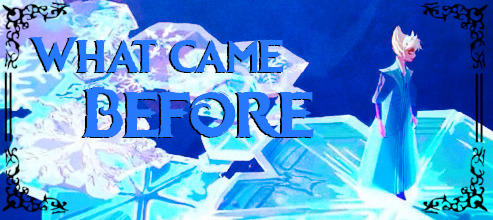
Previous Versions of Frozen (Rewrite)
The development of Frozen is famously known to be messy and obscure. Messy, because of the many last-minute changes made even months before the film released. Obscure, because the many versions there were before the final film are kept secret, with only slight tidbits being released and shown, leaving the previous stories being up to one's own imagination.
In my previous attempt to uncover the previous versions of Frozen, there was a lot of information left out or unknown to me at the time, and even some things I got wrong. Thus, I wanted to do a more in depth look at the possible previous Frozen stories, and update any misinformation.
Feel free to comment sources if there is something I missed.
Part 1 - Before Frozen
As everyone knows, Frozen was first considered to be an adaptation of Hans Christian Anderson’s The Snow Queen. However, over the development of the film, the creative team had decided that it would no longer be an adaptation, as at this point, they were just inspired by the fairy-tale and some of its themes – a Snow Queen, an Evil Mirror, an Act of True Love, and a Frozen Heart. Everything else was left alone, with only fan interpretations of what else could’ve been used, but never officially stated.
Before Frozen was even considered, there were couple attempts at adapting The Snow Queen. A common mistake made by many fans is incorrectly assigning concept art, songs, and story ideas from earlier adaptions of The Snow Queen. However, these versions are not actually Frozen, but completely different stories and attempts to adapt the fairy-tale.
The Biography Attempt -- 1937 – 1942
The first attempt at adapting the Snow Queen was to include the story in a bio-pic of Hans Christian Anderson. The Snow Queen was one of the stories that were going to be told in this bio-pic, alongside his other famous works. The rocky development for this bio-pic began in 1937, and ended in 1942 when the USA entered World War II, as Disney shifted into time on War Propaganda, officially halting the production of this project.
The first completed concept of the Snow Queen segment specifically was coined by Mary Goodrich in 1938, a researcher, who wanted to explore the theme of regeneration through faith. It was very faithful to the original tale, and was actually fully complete. However, Norwegian-born researcher Karl Berggrav dismissed the story. He said that while it was a technically good film, with the story being well-written and had no loose ends, it was boring and uninspired.
"This story rounds off everything nicely and ties up loose ends, but it is very uninteresting and just fades out into nothing, or worse than nothing, banality. It is hard to make good animation out of it.” - Karl Berggrav, The Art of Frozen, pg. 10
Walt Disney himself attempted to adapt the story in 1940, but as a live action and animated film. Hans Christian Anderson everyday life would be filmed in live action, while his stories were to be animated. This was going to be a co-production with Samuel Goldwyn and his new studio Samuel Goldwyn Productions, where they would film the live-action sequences.
The Snow Queen -- 1990 – 2006
There were multiple attempts at adapting The Snow Queen during the renaissance era and after. Harvey Fierstein took a chance to pitch an idea for The Snow Queen, but it was shot down. Even Glen Keane attempted to try his hand at an adaption, but just couldn’t find a way to turn the Snow Queen into the sort of fully realized character.
Then, a new team took on the adaptation in 2000. The main idea that the creative team wanted to have was to omit the Trolls and the mirror, trying to explore different ways for Kai to be abducted by the Snow Queen. There was one version of Kai wanting to impress Erica (Gerda's first name change) by joining a whaling ship. The Snow Queen was often shown in artwork riding an orca all over the sea.
There were other versions that followed this initial premise with more comical side characters, ranging from penguins to walruses to, of course, Snowmen. The strangest outline for this version was how Greta (another name change for Gerda) was a devious gold digger, leading Kai to marry the Snow Queen instead.
The Snow Queen was described as a 'Taming of the Shrew" type character, who had a frozen heart that needed to be melted away by the warm and loving Kai.
I love The Taming of the Shrew idea. Take Martha Stewart. She’s tough, smart — a worthy adversary. If she were a doormat of a woman, no one would go after her. -Michael Eisner, Disney War
The artwork for this version was considered to be beautiful and inspiring, but the narrative was simply not compelling enough. Thus, the story was ultimately scrapped and shelved.
The below concepts are often mistaken for early ideas for Frozen, often named early designs for Anna, Kristoff, and Elsa - however, they are actually from the 2000-2003 version of The Snow Queen, while others are from even earlier versions, and are featuring completely different characters.
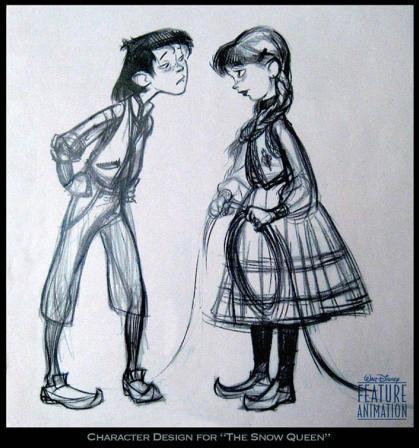
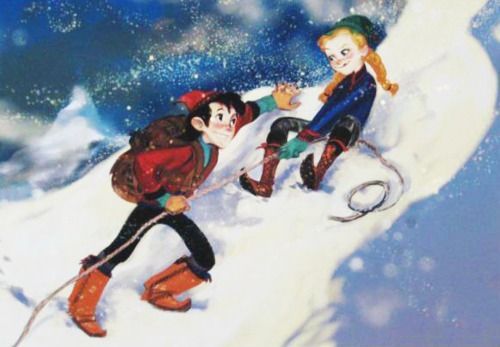
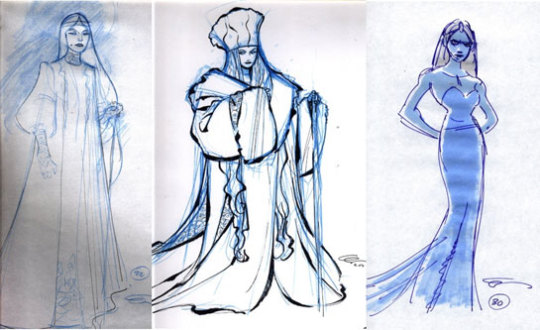
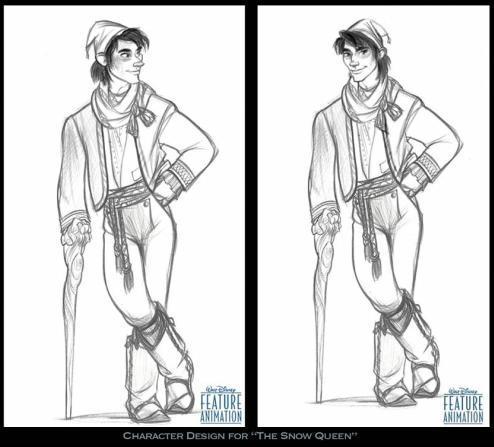
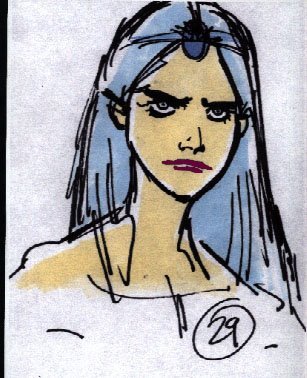
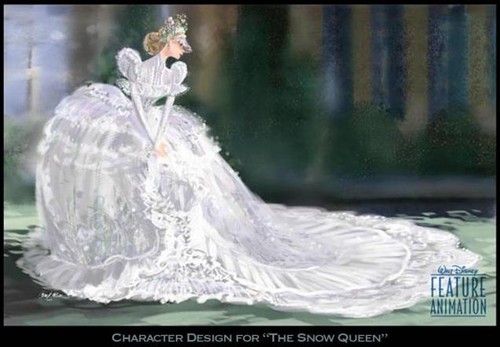
The project was later brought back in 2006, but not for animation - but instead as a stage musical for Tokyo DisneySea at thier Broadway Music Theater. It was going to be directed by Amon Miyamoto, written by John Weidman and Glenn Slater and Alan Menken writing the music. However, it was also scrapped.
The reason I bring this version up, is because a song penned by Slater and Menken is often pushed as early love song that Kristoff was supposed to sing. However, it was not a Kristoff song at all. Love Can't be Denied was a song that was written for this stage musical, with no real details about who it was written for or its purpose in the plot.
youtube
There are many reasons claimed why, but it is often contributed to Disney wanting the Snow Queen Adaptation to be a film, not a stage show. Menken was even reported to try his hand at making it an animated musical, but it never went through.
For years, (Disney had been) working on “The Snow Queen,” first as a stage piece, and then as an animated film, but that got shelved. Clearly, animated films are big commitments and it takes a lot for Disney to greenlight one. - Alan Meken, Jim Hill Media
Part 2 - Previous Versions of Frozen
After John Lasseter was given the reigns of Disney Animation Studios after the Disney merger with Pixar, he wanted to try and adapt this story again. Lasseter convinced his old friend Chris Buck to come back to the studio, and try his hands at another Snow Queen Musical film. Thus, the development of Frozen officially began.
"I pitched several ideas to John, and ‘The Snow Queen’ was one that he'd been interested in for a while. I pitched a musical version of it that he seemed excited by. So we started developing that project. This was back in 2008, around September.” - Chris Buck, The Art of Frozen, pg. 11
Starting 2008, Frozen went through a few versions before Jennifer Lee, Robert Lopez, and Kristen Anderson-Lopez entered the production in 2012. While Jennifer Lee was aware of the project while she was working on Wreck-it-Ralph, as the company typically has round-tables for their animated featured where all of their writers can give notes, she was not officially brought on as writer and then later as director, until 2012.
Both of these versions featured the introduction of Anna and Kristoff as replacements for Gerda and Kai, as adults instead of children. However, there were a few different ideas for The Snow Queen character that would prove to be the biggest obstacle.
Anna and the Snow Queen 2008-2010
The first version of Frozen was called Anna and the Snow Queen. There seems to have been a couple attempts at perfecting this story, none of which really made it to the final cut, due to the difficulty of making the Snow Queen character compelling. This version was meant to have hand-drawn animation at first.
Anna and the Snow Queen is very obscure, and not much exists for its early story ideas other than a few ideas sources from interviews and concept art by Claire Keane.
The Snow Queen Character (she was given the name Elsa at this stage) was based off of Bette Midler (some sources say that she was also meant to be her voice actress) She would take on a very Diva persona, and was of course a villain. Anna at this time was depicted as 'up-tight', and often was shown as some sort of secretary or assistant to the Snow Queen.
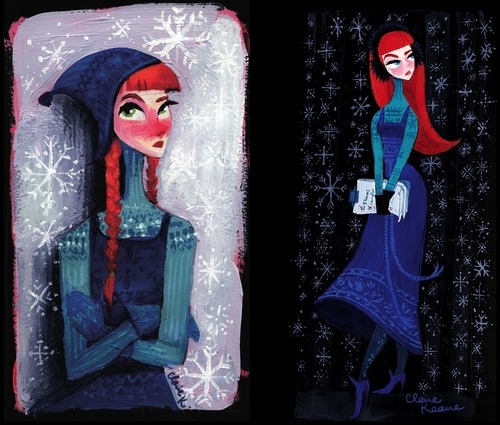
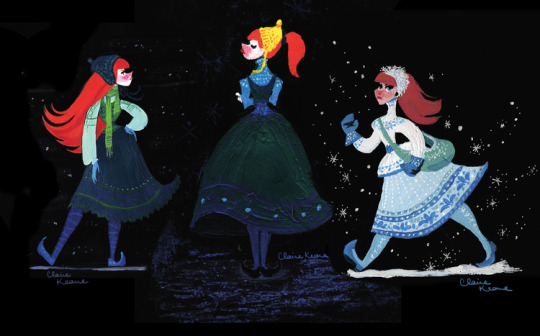
Kristen Bell was cast as Anna before anyone else had joined the team, after she had initially auditioned for the role of Rapunzel for Tangled. Josh Gad was cast a little after, however the Olaf he was voicing was a very different character, much like Anna.
"I was originally involved in the project when it was a 2D effort and it was called Anna and the Snow Queen, and it was completely different. Completely different. Megan Mullally was playing Elsa and it wasn’t really about sisterhood at all. I think it had more to do with the source material of Hans Christian Andersen’s story. When I did that version, Olaf was a different character entirely." - Josh Gad, MSN Entertainment
What the story for this version is often conflicting. Anna goes to the Snow Queen to have her heart frozen after she is dumped at the alter, releasing Elsa from an ice prison. The below concept art by Claire Keane shows Anna as a bride looking for the Snow Queen, supporting this interpretation.

However, other artwork by Keane suggests that Anna is possibly working for the Snow Queen as an assistant of some kind, as shown in the concepts below, and is also supported by the 'up-tight' secretary Anna concepts. It is possible, however, that after going to the Snow Queen to freeze her heart, she ends up working for her. You can also see the Bette Midler inspirations in some of Elsa's character designs.

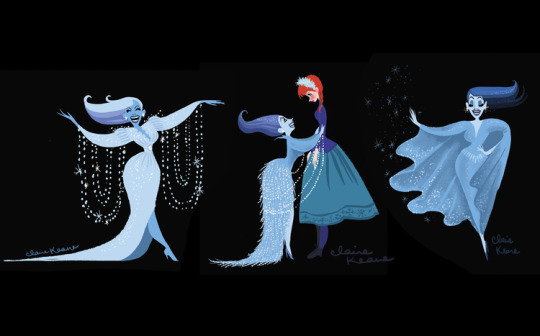
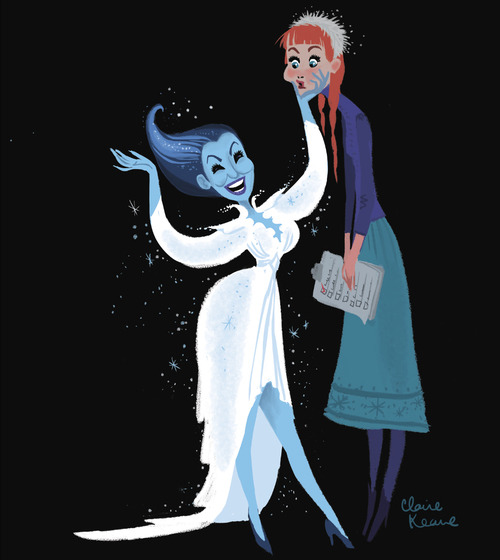

After this period, Anna and The Snow Queen was actually shelved for around one year in 2010, before being brought back in 2011 and renamed to Frozen. It was also around this time that the idea for it to be hand drawn was scrapped, with the film shifting to 3D animation.
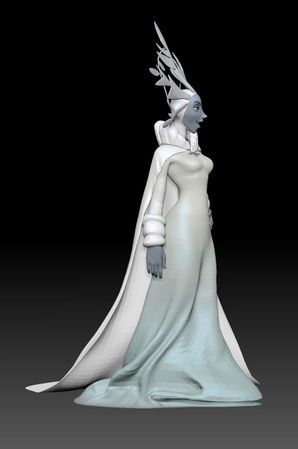
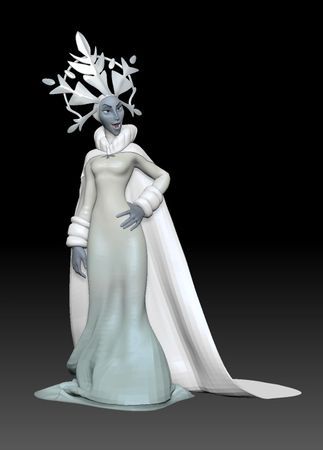
It was seemingly brought back with a story about a prophecy that says that Arendelle would be destroyed by a "Ruler with a Frozen Heart." The characters in the story would assume that this was Elsa, the self-proclaimed Snow Queen (Anna and Elsa were not royalty at this time, nor were they sisters) only for it to be revealed that it was Hans (possibly named Admiral Westergaard).
Frozen was to open with a prophecy that "a ruler with a frozen heart will bring destruction to the kingdom of Arendelle." We're then introduced to Anna, our pure-hearted heroine, and Elsa, an unrelated evil Snow Queen. We learn Elsa is a scorned woman; she was stood up at the altar on her wedding day and froze her own heart so she would never love again. Both Elsa and the audience assume she's the villain from the prophecy. Fast-forward to the final act: Elsa creates an army of snow monsters to attack our heroes while Kristoff has "a Han Solo moment" and comes to help Anna. To halt Elsa's attacking army, the two-faced Prince Hans (Admiral Westergaard) triggers a massive avalanche—not caring that the avalanche also puts Anna, Elsa, and all of Arendelle in jeopardy. Anna realizes Elsa is their only hope, so she convinces her to use her powers to save the kingdom. The twist is that the prophecy from the beginning is actually not about Elsa, but about Hans—he's the one with a metaphorical frozen heart because he's an unfeeling sociopath. Elsa's heart is then unfrozen allowing her to love again. - Peter Del Vecho, Entertainment Weekly
This is also supported with what Santino Fontana says in his interview with Paul Wontorek. He claims that he was hired and paid for his lines in 2011, way before Jennifer Lee was officially involved with the project in 2012, and just after Frozen was brought back from its year hold.
This puts into perspective any claims about Jennifer Lee basing Hans' character after her ex-husband, or that Hans was originally meant to be a good guy until they needed a new villain to replace Elsa. Hans was always meant to be the real villain of Frozen and was seemingly created as soon as Anna and the Snow Queen became Frozen.
The Story of Sisters -- 2011-2012
During one of the round-table sessions, in which Jennifer Lee was involved in but was still not working on Frozen, someone within the session suggested that Anna and Elsa should be sisters. This was the first major breakthrough that helped shape the story.


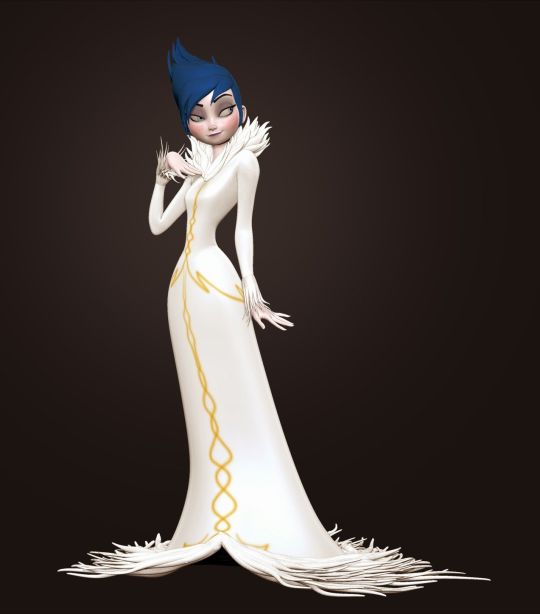

This famous version of Elsa (onionElsa!) is meant to be based off of Amy Winehouse. It is unclear when Elsa's backstory transitioned from being that of a woman who was dumped at the altar, and being the more tragic villain that was forced to hide her magic.
Regardless, it was explained that this Elsa had ran away from her kingdom, and later on kidnapped Anna away from her wedding with Admiral Westergaard, trying to freeze her heart so that Anna would understand how she felt. It ended in the same way, however, with Hans being revealed as the true villain and Elsa getting a redemption.


It was also around this time that Anna's character was also getting a much needed re-working. Anna's 'up-tight' personality was removed with the help of Kristen Bell, who always had issues with Anna’s characterization. She pushed for Anna to be more quirky and awkward, with a strong desire for love and companionship. Idina Menzel was also brought on at this time, where the two actresses prepared a song (Wind Beneath my Wings) to see how their voices would match up.
This deleted scene below showcases this version of Elsa, voiced by Idina Menzel.
youtube
"We did a version where the Snow Queen was the villain, but we wanted to end with them reunited, and it was very hard to redeem her at the end. We decided on an adventure about two people who initially misunderstand each other; it allows for the bonding at the end.” - Peter Del Vecho, The Art of Frozen pg. 12
Jennifer Lee started on the project after all of this was already established, and tried to work out quite a few things with the story. Robert Lopez and Kristen Anderson-Lopez also came onto the project, and tried to write a few songs for this version - although, they didn't really like the story all too much.
One of the songs we know from this version was We Know Better. Interestingly, this is actually not the full song. It is supposed to end with Elsa's turn to becoming ‘evil’, and Anna becoming her 'up-tight' persona. This was omitted with a lot of earlier scenes of Elsa's evil nature (with the exception of the above clip) because the creative team wanted to try and distance Elsa away from this persona.
youtube
Another deleted song was called Cool With Me. @stitchkingdom saw a concert where Kristen and Bobby Lopez performed some deleted songs, some of which were never performed anywhere. Cool with Me was a song that came before Life's Too Short, and has details about Elsa kidnapping Anna and wanting her to feel her own pain.
The next breakthrough for the story was when the Lopezes wrote Let it Go. John Lasseter had often made notes about delving deeper with Elsa's character asking why she is a villain. Jennifer Lee also pushed for more depth when she was writing Elsa. However, Let it Go was the trigger that helped se things in motion for a new version of Frozen.
“The minute we heard the song for the first time, I knew that I had to rewrite the whole movie.” - Jennifer Lee
Now, Elsa was being completely re-written as a sympathetic character - no more villainous tendencies, no more intentionally cruel stunts. Elsa was made into a tragic character who was forced to hide who she was, and only wanted to protect Anna and her kingdom from her powers.
Olaf was also re-written at around this time, going from an obnoxious side-kick of Elsa's to a more innocent companion that would represent the love between the sisters.
The newest version of the story was a mash-up of the original prophesy version talked about above, but with new elements. This included a story about Anna feeling less than Elsa, and feeling like nothing more than a spare. Elsa was of course changed to her new sympathetic character, and runs away from Arendelle from fear rather than being angry at anyone.
The Duke of Weselton was also theoretically introduced at this stage, but not as a red herring to Hans, but instead as a care taker to the sisters after their parents passed away. Hans was also supposed to gift Anna a special snow globe that had some kind of thematic importance.
The following songs and scenes are some of the ideas from this version of Frozen.
youtube
youtube
youtube
youtube
youtube
At this point, the creative team was pretty confident that they had the story planned it out and it was ready to go. However, the team had decided that they were still having issues with the plot.
The Final Months - 2013
From February to June of 2013, there were extensive rewrites done to the film before having a test screening with both a family audience and adult audience.
One of the elements that were changed was the prophecy. After so many years, this story element was finally dropped. Then, Hans' sociopathy was explored more extensively by Jennifer Lee, and a character twist was pushed by John Lasseter to make his villainy more iconic.
Anna's feelings about being a spare was removed, as the creative team wanted to focus more on Anna wanting to find love rather than trying to prove herself (she was sounding a bit too much like Hans). The Duke was changed to being his current self.
Kristoff was actually changed as well, making him a bit more kind. However, when his character was changed is not clear, but we do know that Johnathan Groff pushed for him to be a bit more kind as well.
Some of the songs were also removed and replaced with the current versions we know and love today.
Conclusion
Frozen’s 10th Anniversary is coming up (here or passed depending on when this is read) making it a perfect time to talk about the journey Frozen went on throughout the years. It’s amazing to look back at all the attempts and stories, and see where Frozen ended up. It’s because of all these attempts, successes, failures, and hard-working people that we were able to get the Frozen that we have today.
Happy Frozen 10!
Sources:
The Art of Frozen by Charles Solomon
Disney War by James B. Stewart
Disney's 'Frozen,' Formerly 'The Snow Queen,' Will Be CG Rather Than Hand-Drawn by Russ Fischer for Slash Film
Countdown to Disney's Frozen by Jill Hill for Jill Hill Media
Lost Media Wiki - Frozen
Frozen Original Ending Revealed - James Hibberd, Entertainment Weekly
Show People With Paul Wontorek Interview: Santino Fontana on "Act One," "Frozen" & More
Interview: Frozen's Josh Gad MSN Entertainment
Scriptnotes, Ep 128: Frozen with Jennifer Lee
Exploring the Songs of "Frozen" with Kristen Anderson-Lopez '94
Kristen Bell Explains How She Became Anna in 'Frozen' | The Watch | The Ringer
#Frozen#Elsa#Anna#Hans#Prince Hans#Queen Elsa#Princess Anna#hans westergaard#Kristoff#kristoff bjorgman#Olaf#Sven#greatqueenanna/analysis#frozen 10th anniversary#frozen10#Youtube
149 notes
·
View notes
Text
THIS DAY IN GAY HISTORY
based on: The White Crane Institute's 'Gay Wisdom', Gay Birthdays, Gay For Today, Famous GLBT, glbt-Gay Encylopedia, Today in GGay History, Wikipedia, and more … January 2



1801 – Explorers Alexander Henry and David Thompson make an entry in their journal titled Exploration and Adventure among the Indians on the Red, Saskatchewan, Missouri, and Colombia Rivers describe a Native American known as Berdache, son of Sucrie, who is a "curious compound between a man and a woman."


1900 – (Charles William) Billy Haines (d.1973) was an American film actor and interior designer. He was a star of the silent era until the 1930s, when Haines' career was cut short by MGM Studios due to his refusal to deny his homosexuality. Haines never returned to film and instead started a successful interior design business with his life partner and was supported by friends in Hollywood.
Billy Haines was born in Staunton, Virginia. Haines ran away from home at the age of 14, accompanied by another unidentified young man whom Haines referred to as his "boyfriend". The pair went to Hopewell, which had a reputation for immorality. Haines and his boyfriend got jobs working at the local DuPont factory for $50 a week. To supplement their income, the couple opened a dance hall, which may have also served as a brothel. His parents, frantic over his disappearance, tracked him through the police to Hopewell. Haines did not return home with them, remaining instead in Hopewell and sending money back home to help support the family. The couple remained in Hopewell until most of the town was destroyed by fire in 1915. Haines moved to New York City settling into the burgeoning gay community of Greenwich Village. It is unclear whether his boyfriend accompanied him.
He worked a variety of jobs before becoming a model. Talent scout Bijou Fernandez discovered Haines as part of the Samuel Goldwyn Company's "New Faces of 1922" contest and the studio signed him to a $40 a week contract.
Haines's career began slowly, as he appeared in extra and bit parts, mostly uncredited. His first significant role was in Three Wise Fools (1923). However, he continued to play small, unimportant parts at Goldwyn. It was not until they loaned him to Fox in 1923 for The Desert Outlaw that he got the opportunity to play a significant role. In 1924, MGM lent Haines to Columbia Pictures for a five-picture deal. The first of these, The Midnight Express (1924), received excellent reviews and Columbia offered to buy his contract. The offer was refused and Haines continued in bit roles for Goldwyn.
On a trip to New York in 1926, Haines met James "Jimmie" Shields, probably as a pick-up on the street . Haines convinced Shields to move to Los Angeles, promising to get him work as an extra - some sources say Shields worked as Haines' "double' in his films. The pair were soon living together and viewed themselves as a committed couple.
In 1933, Haines was arrested in a YMCA with a sailor he had picked up in Los Angeles' Pershing Square. Louis B. Mayer, the studio head at MGM, delivered an ultimatum to Haines: choose between a sham marriage (also known as a "lavender marriage") or his relationship with Shields. Haines chose Shields and they remained together for almost 50 years. Mayer subsequently fired Haines and terminated his contract, quickly recasting Robert Montgomery in roles that had been planned for Haines. Haines did make a few minor films then retired from film.
Haines and Shields began a successful dual career as interior designers and antique dealers. Among their early clients were friends such as Joan Crawford, Gloria Swanson, Carole Lombard, Marion Davies and George Cukor. Their lives were disrupted in 1936 when members of the Ku Klux Klan dragged the two men from their home and beat them, because a neighbor had accused the two of propositioning his son. Crawford, along with other stars such as Claudette Colbert, George Burns, Gracie Allen, Kay Francis, and Charles Boyer urged the men to report this to the police. Marion Davies asked her lover William Randolph Hearst to use his influence to ensure the neighbors were prosecuted to the full extent of the law, but ultimately Haines and Shields chose not to report the incident.
Haines and Shields remained together for the rest of their lives. Joan Crawford described them as "the happiest married couple in Hollywood."
Haines died from lung cancer in Santa Monica, California at the age of 73, a week short of his 74th birthday, which was on the new year of 1974. Soon afterward, Shields, who suffered from what many believe to be Alzheimer's Disease, put on Haines' pajamas, took an overdose of pills, and crawled into their bed to die. They were interred side by side in Woodlawn Memorial Cemetery.


1928 – Ray Kassar was president, and later CEO, of Atari Inc. from 1978 to 1983. He had previously been executive vice-president of Burlington Industries, the world's largest textile company at the time, and president of its Burlington House division. A member of the Board of Directors, Kassar had spent over thirty years at Burlington.
Ray Kassar was hired in February 1978 as president of Atari Inc.'s consumer division by Warner Communications, which at the time owned Atari. By this time, rifts had begun to develop between the original Atari Inc. staff (most of whom had engineering backgrounds) and the new hires brought in by Warner (who, like Kassar, mostly had business backgrounds).
In November 1978, when Atari Inc. co-founder Nolan Bushnell left the company after a dispute with Warner over the future of Atari Inc., Kassar became CEO. Under his leadership, sweeping changes were made at Atari and the laid-back atmosphere that had existed under Bushnell's leadership all but disappeared. Kassar's twenty-five years at Burlington Industries had given him a taste for order, organization, and efficiency and his efforts to revamp Atari along similar lines provoked substantial animosity. Kassar shifted the focus away from game development and more toward marketing and sales. Atari Inc. began to promote games all year around instead of just at the Christmas season. R&D also suffered deep cuts and the discipline and security at Atari Inc. became strict.
In a sense he also helped create the video game maker Activision. While Kassar was at Atari he angered a large number of the game developers by not crediting them in any way to the point where they walked out of Atari. He told them that they were no more important to the games then the people that worked on the assembly line. They started their own company and called it Activision.
Ray Kassar is the namesake the widely popular game “ Yar’s Revenge.” The creator of the game was a former employee at Atari “Yar” is Ray spelled backwards. The title is a deliberate jab at Kassar, mocking his dictator-like work ethic as well as his flamboyant manner. Ray Kassar was known by the employees at Atari to be an extremely flamboyant homosexual outside the work place. Employees didn't care what his sexual preferences were, but they were irked by his daily habit of being chauffeured to work in a limo and then proceeding to make grand entrances into the office.
Kassar built Atari into a video game giant that it was, before he was forced to resign because of allegations of insider trading in 1983. He sold all of his shares in Atari just hours before a report was published that Atari had suffered monetary loses in the millions.


1929 – Charles Beaumont (d.1967) is born Charles Leroy Nutt. He was an American author of speculative fiction, including short stories in the horror and science fiction subgenres. He is remembered as a writer of classic Twilight Zone episodes, such as "The Howling Man", "Miniature", "Printer's Devil", and "Number Twelve Looks Just Like You", but also penned the screenplays for several films, among them 7 Faces of Dr. Lao, The Intruder, and The Masque of the Red Death.
In 1954, Playboy magazine selected his story “Black Country.” Playboy has been loved by straight men for decades but it was this gay short story that built its reputation. Hugh Hefner was the only one to accept a science fiction story about heterosexuals being the minority against homosexuals. When letters poured in, he said: 'If it was wrong to persecute heterosexuals in a homosexual society, then the reverse was wrong too.'


1949 – Christopher Durang is an openly gay playwright, screenwriter, and actor whose works have been produced on and off-Broadway and regionally since the late 1970s. A fiercely satirical comic dramatist, Durang often incorporates gay themes and gay characters in his plays.
Durang's breakthrough in achieving critical and financial success came in 1981 with the Off-Broadway production of his scathing one-act play, Sister Mary Ignatius Explains It All For You (written in 1979), which has over the years become a popular vehicle for actresses as diverse as Nancy Marchand, Cloris Leachman, Lynn Redgrave, and many others.
In Sister Mary Ignatius... , Durang draws on his childhood experiences as a student in Catholic school. He satirizes the unbending dogmatism of the eponymous Catholic nun, who is oblivious to the absurdity of what she believes and to the harm that she causes. When four former students, one of them a contented gay man, return to embarrass Sister, she shoots two of them (including the gay man) dead.
Durang often creates hyper-sexual characters (both gay and straight) in an attempt to unhinge attitudes about sexual behavior. In Sister Mary Ignatius..., the gay character explains his homosexuality to his former teacher: "I was seduced when I was in the seminary... and then I went to New York and I slept with five hundred different people."
In Durang's more recent work, straight characters take on the hyper-sexuality stereotypically associated with gay men. Lulu in Sex and Longing needs to have sex every fifteen minutes, while in Betty's Summer Vacation, Buck proudly displays a scrapbook containing photos of his penis. Durang's is a distinctive voice in American comedy, at once angry, intelligent, and queer.
He lives in Bucks County with his partner, John Augustine; they have been together for more than 20 years.


1961 – Todd Haynes is an American independent film director and screenwriter. He is best known for his feature films Superstar: The Karen Carpenter Story, Poison, Velvet Goldmine, Safe, and the Academy Award-nominated Far from Heaven and I'm Not There.
In 1987, while an MFA student at Bard College, Haynes made a short, Superstar: The Karen Carpenter Story, which chronicles the life of American pop singer Karen Carpenter, using Barbie dolls as actors. The film presents Carpenter's struggle with anorexia and bulimia, featuring several close-ups of Ipecac (the prescription drug Carpenter was reputed to have used to make herself vomit during her illness). Carpenter's chronic weight loss was portrayed by using a "Karen" Barbie doll with the face and body whittled away with a knife, leaving the doll looking skeletonized. The film is also notable for staged dream sequences in which Karen, in a state of deteriorating mental health, imagines being spanked by her father.
Superstar featured extensive use of Carpenter songs, showcasing Haynes' love of popular music (which would be a recurring feature of later films). Haynes failed to obtain proper licensing to use the music, prompting a lawsuit from Karen's brother Richard Carpenter for copyright infringement. Carpenter was reportedly also offended by Haynes' unflattering portrayal of him as a narcissistic bully, along with several broadly dropped suggestions that he was gay and in the closet. Carpenter won his lawsuit, and Superstar was removed from public distribution; to date, it may not be viewed publicly. Bootlegged versions of the film are still circulated, and the film is sporadically made available on YouTube.
Haynes' 1991 feature film debut, Poison, garnered Haynes further acclaim and controversy. Drawing on the writings of "transgressive" gay writer Jean Genet, the film is a triptych of queer-themed narratives, each adopting a different cinematic genre: vox-pop documentary ("Hero"), 50s sci-fi horror ("Horror") and gay prisoner love story ("Homo"). The film explores traditional perceptions of homosexuality as an unnatural and deviant social force, and presents Genet's vision of sado-masochistic gay love as a subversion of heterosexual norms, culminating with a marriage ceremony between two gay male convicts. Poison marked Haynes' first collaboration with producer Christine Vachon, who has since produced all of Haynes' feature films.
Poison was partially funded with a grant from the National Endowment for the Arts. The film subsequently became the center of a public attack by Reverend Donald Wildmon, head of the American Family Association, who criticized the NEA for funding Poison and other works by gay and lesbian artists and filmmakers. Wildmon, who had not viewed the film before making his comments publicly, condemned the film's "explicit porno scenes of homosexuals involved in anal sex", despite no such scenes appearing in the film.
Poison went on to win the 1991 Sundance Film Festival's Grand Jury Prize, establishing Haynes as an emerging talent and the voice of a new transgressive generation. The film writer B. Ruby Rich cited Poison as one of the defining films of the emerging New Queer Cinema movement, with its focus on maverick sexuality as an anti-establishment social force.
Haynes achieved his greatest critical and commercial success to date with Far From Heaven (2002), a 1950s-set melodrama inspired by the films of Douglas Sirk about a Connecticut housewife Cathy Whittaker (Julianne Moore) who discovers that her husband (Dennis Quaid) is secretly gay, and subsequently falls in love with Raymond, her African-American gardener (Dennis Haysbert).
Haynes is openly gay. He currently lives in Portland, Oregon.


2005 – Bonnie Bleskachek became the first openly lesbian fire chief of a major city, Minneapolis. She was demoted two years later amid claims of harassment and discrimination, but return to the department as a staff captain. She co-founded the Minnesota Women Fire Fighters Association.


22 notes
·
View notes
Text

“The Count of Monte Cristo,” one of four films on France’s shortlist for the country’s official submission to the Academy Awards, will open on Dec. 20 in U.S. theaters. Samuel Goldwyn Films plans to campaign the three-hour adventure drama in all categories including best picture, with the release to roll out nationwide after its bow. [...] “The Count of Monte Cristo” premiered at this year’s Cannes Film Festival, where it received a lengthy standing ovation and positive reviews. It will make its U.S. premiere at the Hamptons International Film Festival and then play events including the American French Film Festival in Los Angeles. Currently sitting at 100% on Rotten Tomatoes, “The Count of Monte Cristo” has sold more than 8 million tickets in France and grossed over $75 so far internationally, with most major markets still to come.
#le comte de monte cristo#the count of monte cristo#Pierre Niney#Bastien Bouillon#Anaïs Demoustier#Anamaria Vartolomei#Laurent Lafitte#Pierfrancesco Favino#Patrick Mille#Vassili Schneider#Julien De Saint Jean#Adèle Simphal#Stéphane Varupenne#Matthieu Delaporte#Alexandre de La Patellière#dailyworldcinema
48 notes
·
View notes